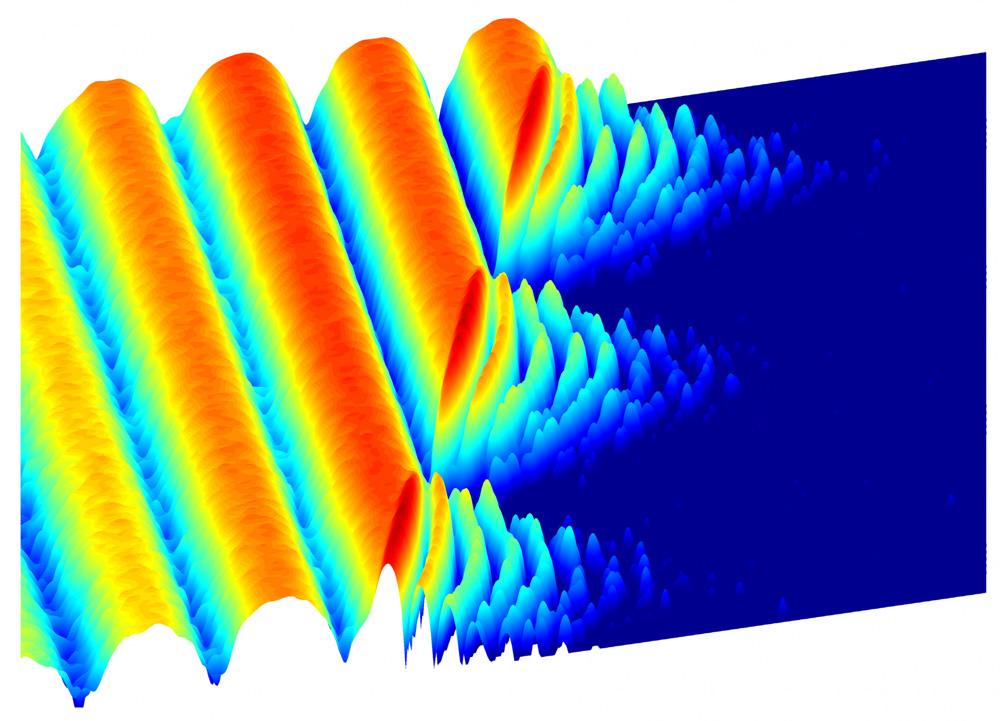Could ‘solid’ light compute previously unsolvable problems?
September 12, 2014

Oscillations of photons create an image of frozen light. At first, photons in the experiment flow easily between two superconducting sites, producing the large waves shown at left. After a time, the scientists cause the light to “freeze,” trapping the photons in place. Fast oscillations on the right of the image are evidence of the new trapped behavior. (Credit: Princeton University)
Researchers at Princeton University have “crystallized” light. They are not shining light through crystal — they are actually transforming light into crystal, as part of an effort to develop exotic materials such as room-temperature superconductors.
The researchers locked together photons so that they became fixed in place. “It’s something that we have never seen before,” said Andrew Houck, an associate professor of electrical engineering and one of the researchers. “This is a new behavior for light.”
The results raise intriguing possibilities for a variety of future materials, and also address questions in condensed matter physics — the fundamental study of matter.
“We are interested in exploring — and ultimately controlling and directing — the flow of energy at the atomic level,” said Hakan Türeci, an assistant professor of electrical engineering and a member of the research team. “The goal is to better understand current materials and processes and to evaluate materials that we cannot yet create.”
The team’s findings, reported online Sept. 8 in the journal Physical Review X (open access), are part of an effort to answer fundamental questions about atomic behavior by creating a device that can simulate the behavior of subatomic particles.
Special-purpose quantum computers
Such a tool could be an invaluable method for answering questions about atoms and molecules that are not answerable even with today’s most advanced computers. In part, that’s because current computers operate under the rules of classical mechanics, while the world of atoms and photons obeys the rules of quantum mechanics, which include a number of strange and very counterintuitive features.
One of these odd properties is called “entanglement,” in which multiple particles become linked and can affect each other over long distances. A computer based on the rules of quantum mechanics could help crack problems that are currently unsolvable. But building a general-purpose quantum computer has proven to be incredibly difficult.
Another approach, which the Princeton team is taking, is to build a system that directly simulates the desired quantum behavior. Although each machine is limited to a single task, it would allow researchers to answer important questions without having to solve some of the more difficult problems involved in creating a general-purpose quantum computer.
The device could also allow physicists to explore fundamental questions about the behavior of matter by mimicking materials that only exist in physicists’ imaginations.
An ‘artificial atom’ that makes photons behave like particles
To build their machine, the researchers created a structure made of superconducting materials that contains 100 billion atoms engineered to act as a single “artificial atom.” They placed the artificial atom close to a superconducting wire containing photons.
By the rules of quantum mechanics, the photons on the wire inherit some of the properties of the artificial atom — in a sense linking them. Normally, photons do not interact with each other, but in this system, the researchers are able to create new behavior in which the photons begin to interact in some ways like particles.
“We have used this blending together of the photons and the atom to artificially devise strong interactions among the photons,” said Darius Sadri, a postdoctoral researcher and one of the authors. “These interactions then lead to completely new collective behavior for light — akin to the phases of matter, like liquids and crystals, studied in condensed matter physics.”
Radical light
It is of course known from double-slit and other experiments that sometimes light behaves like a wave and other times like a particle. But the Princeton researchers have engineered a whole new particle behavior.
“Here we set up a situation where light effectively behaves like a particle in the sense that two photons can interact very strongly,” he said. “In one mode of operation, light sloshes back and forth like a liquid; in the other, it freezes.”
The current device is relatively small, with only two sites where an artificial atom is paired with a superconducting wire. But the researchers say that by expanding the device and the number of interactions, they can increase their ability to simulate more complex systems — growing from the simulation of a single molecule to that of an entire material. In the future, the team plans to build devices with hundreds of sites with which they hope to observe exotic phases of light such as superfluids and insulators.
“There is a lot of new physics that can be done even with these small systems,” said James Raftery, a graduate student in electrical engineering and one of the authors. “But as we scale up, we will be able to tackle some really interesting questions.”
The research team also included Sebastian Schmidt, a senior researcher at the Institute for Theoretical Physics at ETH Zurich, Switzerland. Support for the project was provided by: the Eric and Wendy Schmidt Transformative Technology Fund; the National Science Foundation; the David and Lucile Packard Foundation; the U.S. Army Research Office; and the Swiss National Science Foundation.
Abstract of Physical Review X paper
Here, we report the experimental observation of a dynamical quantum phase transition in a strongly interacting open photonic system. The system studied, comprising a Jaynes-Cummings dimer realized on a superconducting circuit platform, exhibits a dissipation-driven localization transition. Signatures of the transition in the homodyne signal and photon number reveal this transition to be from a regime of classical oscillations into a macroscopically self-trapped state manifesting revivals, a fundamentally quantum phenomenon. This experiment also demonstrates a small-scale realization of a new class of quantum simulator, whose well-controlled coherent and dissipative dynamics is suited to the study of quantum many-body phenomena out of equilibrium.